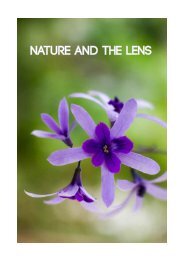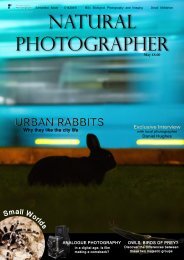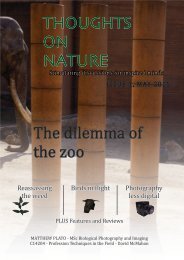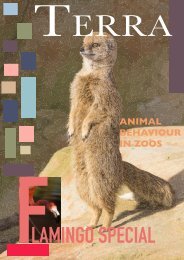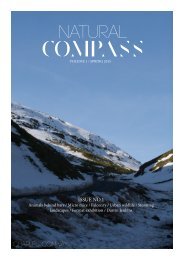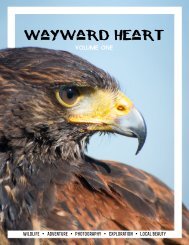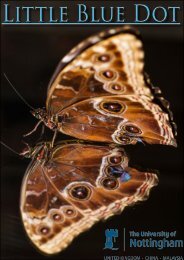Saving Wild Cats
Create successful ePaper yourself
Turn your PDF publications into a flip-book with our unique Google optimized e-Paper software.
Fig 15: An image<br />
from Ashley’s<br />
banner.<br />
A Day with a Dance<br />
Photographer<br />
Before releasing captive animals into the wild, suitable<br />
areas must first be found. The requirements of these<br />
areas are generally that they are within a range historical<br />
to the species and that they are far enough away from<br />
the current wild population to avoid breeding between<br />
the two. It is believed that it is better to try to introduce<br />
a new population as apposed to building upon the<br />
existing one(s). This will prevent genes that have arisen<br />
due to captivity being passed on to the wild population<br />
and reduces the risk of potentially harming the fitness<br />
and chance of survival as a species.<br />
Other requirements would be adequate space and<br />
an abundance of prey. For tigers, the requirement is<br />
at least 100 km2 per tiger. Areas of this magnitude are<br />
not available in China and perhaps controversially, four<br />
Southern China Tigers (two males and two females)<br />
were released in South Africa in 2006 and 2007. This<br />
drew criticism due to the fact that tigers were never<br />
native to Africa and with only a 13% success rate of<br />
captive born species being reintroduced, many are of<br />
the opinion that money and efforts are best spent on<br />
conserving already wild populations. This low success<br />
rate can be attributed to a captive raised animal’s lack<br />
of experience in instinctive behaviours. These include<br />
hunting, exploring and avoidance of humans and<br />
predators. Captive animals are also more susceptible<br />
to disease and so this can also impede their chances of<br />
survival.<br />
Fig 14: A captive Amur<br />
leopard (Panthera pardus<br />
orientalis) leaping from a<br />
climbing structure<br />
Releasing Captive <strong>Cats</strong><br />
Projects such as the release of tigers in South Africa<br />
provide animals with live prey in order to help develop<br />
hunting skills. Few projects however ensure captive<br />
animals are not accustomed to humans. Given the<br />
degree of involvement humans have in caring for<br />
animals in captivity this would be difficult to enforce.<br />
However, releasing animals that do not view humans<br />
as a threat leaves them vulnerable at the hands of<br />
poachers. Ensuring that release areas are protected and<br />
are not within close proximity to areas where humans<br />
live is one way to eliminate this problem.<br />
Although animals may suffer stress as a result of<br />
captivity, many zoos demonstrate a high level of care<br />
for the animals they keep. Allowing people to visit<br />
zoos increases awareness of conservation projects<br />
and the vulnerability of endangered species. This in<br />
turn helps raise funds to facilitate projects and, using<br />
Amur leopards as an example, the majority of funds<br />
contributed to the conservation of wild animals are<br />
raised by zoos. Efforts are also being made to improve<br />
conditions and animal enclosures within zoos. Breeding<br />
programmes within zoos and specialised breeding<br />
centres serve as hope that more and more captive<br />
animals can be successfully released into the wild with<br />
the ultimate goal of regenerating population numbers<br />
and saving endangered species from extinction.<br />
Ashley Holmes (pictured<br />
top right) is a Leicester<br />
based photographer who,<br />
after a career in finance,<br />
began making a living from<br />
photography approximately<br />
four years ago. Starting out as an event photographer<br />
at sports games and tournaments, Ashley now focuses<br />
primarily on dance photography.<br />
I met Ashley for the first time at Groby Community<br />
College where the dance school, Dance Addict’s, were<br />
performing. This was their first show independent of the<br />
college and the dancers involved ranged from three year<br />
old beginners all the way to senior level dancers in their<br />
teens.<br />
Inside the college, the walls leading to the theatre are<br />
lined with photographs of past performances, displaying<br />
a sense of pride and documenting the history of the<br />
school and its students. As the photographer of these<br />
images, Ashley points out a few of his favourites and also<br />
shows me one that is of his own daughter.<br />
‘I fell into dance<br />
photography after<br />
photographing<br />
performances that my own<br />
daughters were part of ’ he<br />
explains. ‘I soon realised<br />
that outdoor photography<br />
in bad weather wasn’t<br />
something I enjoyed very<br />
much so I moved over to<br />
dance where performances<br />
take place inside’. Working<br />
mainly with local dance Fig 17: Ashley in action.<br />
schools, Ashley’s goal is to<br />
document the show and<br />
produce images that act as a lasting memory for both<br />
parents and the dancers themselves. As well as capturing<br />
all the action of the performances, Ashley also attends<br />
the dress rehearsal and at some shows even sets up a<br />
small studio where dancers can pose for portrait images.<br />
Watching the dancers perform can be quite an<br />
emotional experience especially when it involves the<br />
younger ones. You can therefore see the importance of<br />
Ashley’s work and the role he plays in encompassing<br />
that proud moment of a parent seeing their child on<br />
stage. For that reason he focuses on<br />
individuals rather than group shots.<br />
‘Parents don’t tend to want a group<br />
photograph. They prefer an<br />
image of their own child that<br />
they can display proudly in<br />
their home and look back on for years to come’.<br />
Ashley explains to me that when photographing a<br />
Fig 16: Ashley Holmes<br />
dance performance, lighting is the main challenge. As he<br />
has no control over the stage lights and is unable to use<br />
flash, he must do all that he can in camera to overcome<br />
the dark conditions, spot lights and multi-coloured<br />
lights that make up a dance show. Shooting without a<br />
tripod on a Canon 5D Mark II and almost always using<br />
a Canon 70-200mm f2.8 lens, Ashley uses high ISO,<br />
fast shutter speed and wide aperture. Each plays an<br />
important role in the final outcome of his images. High<br />
ISO accounts for the dark lighting whilst wide aperture<br />
allows as much light as possible to enter the camera. This<br />
then allows the use of a fast shutter speed, which freezes<br />
the movement of the dancer.<br />
Fig 18: The lighting<br />
at a dance show<br />
can prove tricky at<br />
times.<br />
After the show it’s time for a quick turn around in<br />
selecting the best images, editing if necessary and<br />
making them available for dancers, teachers, friends and<br />
family to view online. Ashley offers generous discounts<br />
for the purchase of multiple images and his website<br />
testimonials are filled with great reviews and people<br />
thanking him for extra images and excellent deals.<br />
So what does the future hold for Ashley? Continuing<br />
with dance photography whilst pursuing and expanding<br />
on his portrait photography are his main goals. ‘Anyone<br />
with a camera is a photographer. The main thing is<br />
to keep yourself motivated to get out there and do it<br />
professionally’.<br />
You can view Ashley’s images and find out more on his<br />
website at www.ashleyholmesphotography.co.uk<br />
11



